India fertility rate (2000-2025) explained: Past data, current numbers, and how
The fertility rate in India has dropped over the past few decades. Here's what it means, why it matters, and how it compares globally


India’s population is massive, but the population size alone doesn’t tell the whole story of a country’s demographic health. Behind these numbers are several indicators that help determine how a population is changing, and one of the most important among them is the fertility rate.
Over the years, India has witnessed a steady decline in this value, with many parts of the country now reporting lower fertility rates than previously. This isn’t necessarily good or bad on its own, but it does indicate a significant change. From the size of the future workforce to the shape of family structures, fertility rate is closely tied to how societies grow and plan ahead.
In this post, we’ll discuss what the fertility rate means, why it matters, what is driving the decline, and provide past and current data for a better understanding.
Fertility rate or total fertility rate is the average number of children a woman has during her lifetime, based on current birth patterns. It’s a core measure used by demographers to track and predict population growth.
It is calculated using the formula:

This means the number of births occurring per 1,000 women in specific age groups, and sum these across the reproductive age range, usually 15 to 49 years.
It"s often confused with the birth rate, but they are not the same. The birth rate measures the number of live births per 1,000 people in a population, whereas the fertility rate focuses on women and the average number of children they have. The fertility rate gives a clearer picture of population trends over time.
 The fertility rate in India plays a crucial role in shaping long-term demographic structure. If the rate is too high, it can put pressure on housing, healthcare, education, and natural resources. If it"s too low, it may lead to a shrinking population, an ageing workforce, and increased pressure on social welfare systems.
The fertility rate in India plays a crucial role in shaping long-term demographic structure. If the rate is too high, it can put pressure on housing, healthcare, education, and natural resources. If it"s too low, it may lead to a shrinking population, an ageing workforce, and increased pressure on social welfare systems.
India is experiencing a lower fertility rate every year, which is a major concern for the future labour supply. A decline in the number of young people entering the workforce can slow down economic growth and impact policy systems. It also affects sectors such as education and childcare services, which may need to scale back.
On the other hand, healthcare systems may experience higher demand due to an ageing population. By tracking the fertility rate in India, governments can plan better for shifts in demand across various sectors.
First Published: Jul 01, 2025, 18:24
Subscribe Now